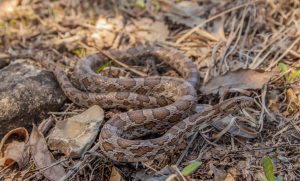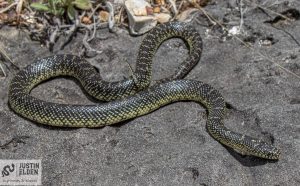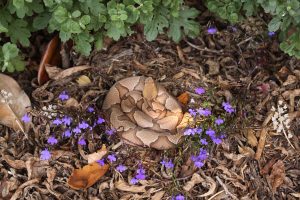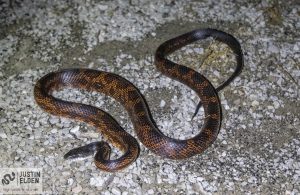Native Snakes of SW Illinois
For a lot of people, the very word reptile conjures up repulsive images of scaly, slimy, slithering creatures–apparitions of evil and danger. If that’s the case for you, read no further. For other folks, reptiles represent a fascinating group of animals which hold a pivotal place among the stunning wildlife of our bluff lands.
Reptiles belong to a class of herpetofauna (aka herps) that are comprised of turtles, lizards and snakes. Reptile comes from a Latin word, reptilia, meaning “to crawl.” Reptiles are distinguished from amphibians by their scaly skin, which protects them from scratches and abrasions much more effectively than the thin, delicate skin of an amphibian. And the skin of a reptile is waterproof and retains body moisture, freeing reptiles from remaining in damp or wet environments.

Twenty-three snake species live in our area: small worm snakes, racers, ringnecks, rare and endangered great plains ratsnakes, black ratsnakes, eastern hognose snakes, prairie kingsnakes, speckled kingsnakes, beautifully colored red milksnakes, exceedingly rare eastern coachwhip snakes, yellowbelly / diamondback / northern water snakes, rough green snakes, Graham’s crayfish snakes, brown snakes, redbelly snakes, state threatened flathead snakes, western ribbon snakes, eastern garter snakes, smooth earth snakes, and our venomous copperheads and timber rattlesnakes. The flathead snake is also venomous having two small, grooved rear fangs and small venom glands that are apparently used to subdue prey, but the snake is no threat to humans. The timber rattlesnake is also state threatened, but has been documented numerous times in the rocky bluffs of Monroe County.

Most reptiles lay amniote eggs. Unlike the naked, exposed eggs of amphibians, the reptile egg is surrounded by a hard protective shell, which protects the developing embryo from drying out and frees reptiles of the necessity of being near water. Unlike amphibians, which have an aquatic water stage, most reptiles hatch from eggs fully developed, a miniature copy of their parents.

However, there are a few snakes that give birth to live young. These include the Easter Timber rattlesnake (6-10 young born late summer or early autumn), Common Garter snake (15-80 young born from July through early October) and Copperhead (three to ten young born in late August or early September).

If you find one in your garage (most likely a black rat snake) they are after mice. As they say, don’t bother them and they won’t bother you.
CLIFFTOP, a local nonprofit organization, is focused on preserving and protecting area bluff lands.
A version of this article appeared in the May 17, 2023 edition of the Republic-Times.
©2023 all content rights reserved Clifftop NFP
Comments are currently closed.
